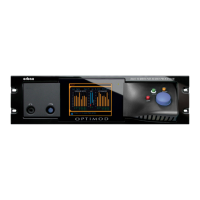OPTIMOD SURROUND PROCESSOR INTRODUCTION
1-15
The 8685 provides a BNC connector that accepts “house sync” in AES11id (75Ω un-
balanced) or 1 x word clock (squarewave at the sample frequency) format. The 8685
automatically detects which of these signals is present, if any. A setup menu selec-
tion determine whether the 8685’s outputs are synchronized to the 8685’s sync in-
put, its internal clock, or the signal applied to its AES3 audio input, If the optional
HD-SDI module is installed, this adds two more allowable sync sources: video sync
and a signal applied to the SDI input (see below).
Because the 8685’s digital input receivers have sample rate converters, these inputs
can accept any sample frequency from 32 to 96 kHz. These inputs do not need to be
synchronized to house sync.
In the optional HD-SDI module, a BNC connector can accept video sync per SMPTE
274M and SMPTE 296M. This can be used as a reference for the sample rate at the
AES3id outputs and to correctly align Dolby-E frames with video per Dolby's re-
quirements (SMPTE RDD 6-2008 and Dolby Labs published specifications) in cases
where HD-SDI is not in use.
When an HD-SDI or SDI signal is present at the SDI input, this signal supplies Dolby-E
frame sync and a reference for the sample rate appearing at the 8685’s AES3id out-
puts. As with the base configuration, these outputs can also be synchronized to the
AES11/wordclock input, the signal appearing on AES3id input 1/2, or the 8685’s in-
ternal timebase.
The AES3id inputs are equipped with sample rate converters, so they can receive
signals that are not locked to house sync.
Using the 8685 to Control Studio Output Levels
The 8685 can be used to process a live production like a sports remote or news stu-
dio for consistency. In this case, the 8685 is usually not the final peak control device
in the audio chain before the station’s on-air encoder or transmitter. In these appli-
cations, it is wise to minimize the amount of peak limiting by turning down the
F
INAL LIMIT DRIVE control in the 8685’s active preset until the 8685’s limiting meters
show little or no gain reduction.
If the 8685 is outside the studio, it is common for the audio to be linked to the stu-
dio via a lossy digital STL. See the comments about minimizing peak limiting in the
section Using Lossy Data Reduction before the 8685’s Input on page 1-13 .
AV-Sync Delay
The 8685’s audio processing provides an adjustable audio time delay of up to 60 mil-
liseconds. This allows the installer to force the total delay through the processing to
be exactly one or two frames. (Two frames are required for 59.94/60 fps progres-
sively scanned video.) The definition of “frame” depends on the system in which
OPTIMOD 8685 is installed.
The selections are MINIMUM (approximately 24 ms delay), 30 fps (NTSC
monochrome video), 29.97 fps (NTSC color video), 25 fps (most PAL
video), and 24 fps (film). You can also adjust the delay in one-millisecond
increments from 25 to 60 ms.

